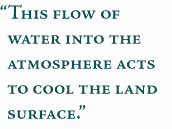

|
Evapotranspiration and Greenhouse Warming
During photosynthesis, thousands of tiny valve-like pores (called "stomates") on a plant's green leaves open up to allow carbon dioxide to flow into the leaf interior. Consequently, water lining the stomatal cavity can escape from inside the leaf out to the open air. This flow of water into the atmosphere acts to cool the land surface. As the water in the leaf is depleted, it is replaced by a flow of liquid water taken up from the soil by the plant's root system. Plants appear to continuously modulate the width of their stomates so as to get a maximum rate of photosynthesis for a minimum loss of water.
As concentrations of atmospheric carbon dioxide increase, plants may be able to reduce their evapotranspiration rates (water loss) to cause no reduction, or maybe even a slight increase, in photosynthesis. Some studies have modeled this effect and calculate that as carbon dioxide increases, evapotranspiration erasure over the continents will decrease, effectively reducing the amount of water vapor in the atmosphere. If this happens and greenhouse warming will be further amplified over the tropical land areas by as much as 50 percent above the predicted greenhouse warming effect alone (Figure 2). next: Plants, Snow & Ice
|

|